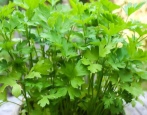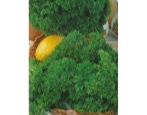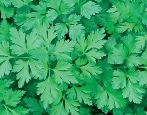
- Year of approval: 1950
- View: root
- Leaf color: dark green
- Petiole coloration: light green
- Length : medium
- Diameter, cm: 4
- The form: conical
- Coloration: grayish white
- Weight, g: 25-60
- Weight of one green plant, g: 80-90
Root parsley is a greenery common in the circles of Russian summer residents, known for its unpretentious care. One of the popular varieties of the plant is Sugar Parsley. This root variety has been approved for use since 1950, and for more than 70 years, Sugar Parsley has not lost its popularity.
Description of the variety
Sugar parsley has a good taste and features the same size and shape of the roots. The foliage is tall, making harvesting easier. Greens contain a lot of sucrose, B vitamins, water and essential oils. Also among the advantages it is worth noting the good keeping quality of the variety.
Appearance
The rosette of this plant is spreading, well developed, has 20-40 dark green leaves. Each plant weighs about 80-90 g, and the mass of one root vegetable is about 25-60 g. Root crops are conical in shape, their length is 20-22 cm, the skin is grayish-white, inside the white pulp there is a light yellow core.
Purpose and taste
Sugar variety has an excellent taste and a pronounced pleasant aroma. This product can be used for any culinary purpose. It is allowed to dry, boil, steam, blanch, use for canning, sprinkle ready meals with it. In addition, this parsley contains a large amount of nutrients and can be used as an additional source of vitamins, for example, a useful decoction or infusion can be prepared from it.
Ripening terms
From the beginning of germination to the state of technical ripeness, it usually takes 97-103 days, which indicates that Sugar Parsley belongs to the early ripening varieties. Harvesting more often occurs in July.
Yield
It is a high-yielding variety that yields on average 2.0-2.8 kg of root crops per square meter.
Growing and care
Sowing is carried out in late April or early May, the seeds are sown directly into the ground. When choosing a garden, give preference to sunny areas. Follow-up care consists of the following steps.
- Fertilizer. In total, five dressings are required for the entire growth period. Potassium, ammonium nitrate, ash are suitable as food.
- Watering. The frequency of irrigation depends on the climatic conditions in which the plant is grown, as well as on the composition and looseness of the soil. Usually, for the entire growing season, it is enough to water the crop 4-5 times. Each square meter will require two buckets of warm water. Watering is carried out in the morning or evening. A drip irrigation system may be relevant. After each wetting, it is recommended to loosen the soil and weed out.
- Thinning. The procedure is performed after germination and again after a couple of weeks. This manipulation is mandatory, since the extra shoots take up nutrients and moisture. Thinning is carried out up to a distance of 3-5 cm between the bushes. With the second thinning, the distance increases to 10 cm, after which the culture is fertilized.
- Maintaining light. As already mentioned, the site should be well lit by the sun, a little shade is allowed in the morning and at noon, but if the sun's rays do not reach the garden at all, then fluorescent lamps should be used.
Disease and pest resistance
Sugar parsley cannot boast of strong immunity against certain diseases and insects.For example, it can be affected by rust, white rot, spotting; from pests, carrot fly, leaf flies, melon aphids are not indifferent to it. As a preventive measure, observe crop rotation and plant a crop in the same area every 3-4 years. Before sowing, process the seeds for half an hour, and when the first symptoms of the disease appear, spray the plant with 1% Bordeaux liquid.







































